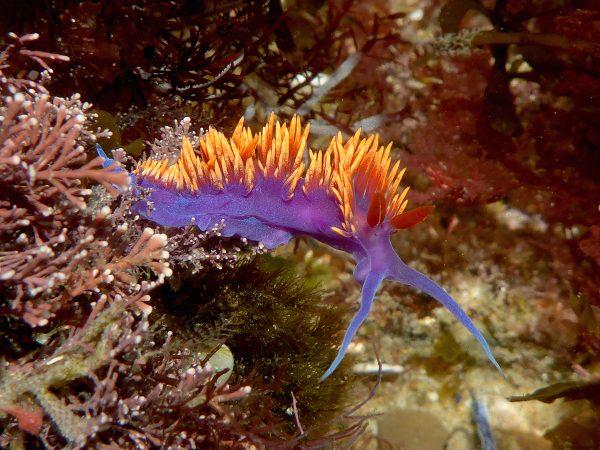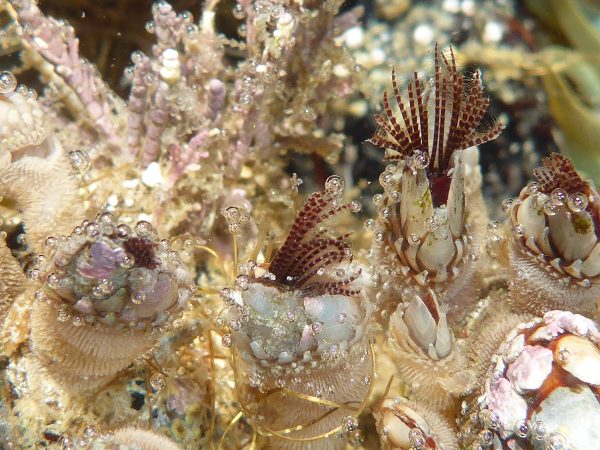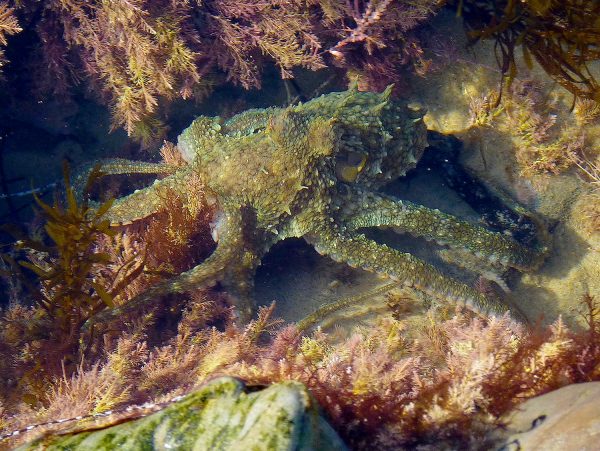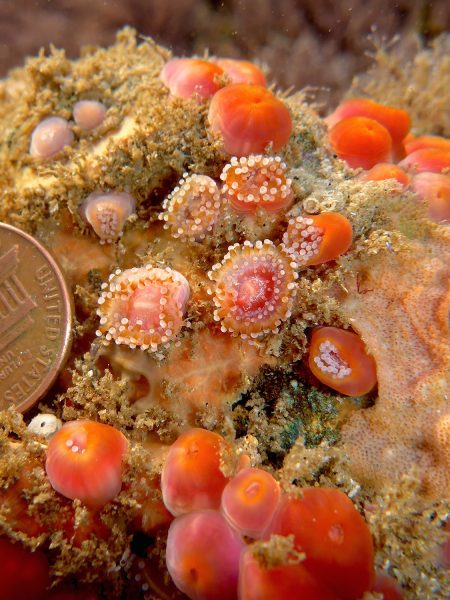by Rita Robinson | Special to the LB Indy

The ocean is the primordial barometer of all that’s right with the world. If it’s unhealthy, all bets are on that extensive environmental decline is just a matter of time.
Over the past five years, ocean life looked bleakfor local tidepools,which form a significant first-line indicator of overall ecological health. But for the last six months, intertidal activity, including spawning, spooning and spore broadcasting, is making a comeback.
“Puppy piles of sea stars are back,” said Tim Arehart, an intertidal interpreter at Crystal Cove State Park and Laguna Beach tidepools for the last eight years. “And black sea hares are all over the place now. They’re breeding and laying spaghetti-like strings of eggs.”
They’re also gobbling up an invasive seaweed called sargasm. It’s no joke, “the balance is being maintained,” said Arehart.
But the flurry of activity may only be temporary.
The intertidal scene has changed from moonscape to intertidal oasis with what Arehart calls the return of “The Big Seven” — octopus, sea star, sea urchin, black sea hare, red sea hare, Hopkin’s Rose nudibranch and Spanish Shawl nudibranch — but in small measure.
“Even though things look really healthy right now, if you went back and looked at the tidepools 20 to 40 years ago, you’d see really dramatic change,” said Piper Wallingford, a UCI doctoral student studying global change ecology and how global warming will alter ecological communities. “Think of things like sea stars and how abundant they used to be and now it’s exciting to see just two or three.”
 Wallingford and Arehart recently spoke at a continuing education workshop for naturalists sponsored by Laguna Ocean Foundation and Crystal Cove State Park at the Ocean Institute in Dana Point.
Wallingford and Arehart recently spoke at a continuing education workshop for naturalists sponsored by Laguna Ocean Foundation and Crystal Cove State Park at the Ocean Institute in Dana Point.
Wallingford says the slightly improved conditions are a brief respite in a spiral of environmental degradation that can only be stopped if people care enough to change.
The most urgent change, she said, is radically reducing carbon dioxide emissions.
“It’s the only way to prevent the worse-case scenario,” she said. “We can’t afford to take the passive approach of business-as-usual. If we stay at the same rate we’re at now, it will make things even worse than they are.”
California mussels have declined by almost 40 percent in the last 40 years, Wallingford said. “There’s a lot of species that depend on the mussels for habitat and food. This is having a trickle-down effect,” she said. “These are things we expect are going to get worse.”
El Nino conditions, which also destroy kelp forests, are just a precursor to more permanent warm-water temperatures, said Wallingford. “The greatest crisis our tidepools are facing as well as a lot of our ecological communities is climate change,” she said.

The recent resurgence stems from colder local ocean water temperatures, dropping about 10 degrees below warm-water El Nino conditions. Cold water, 68 degrees and below, is nutrient-rich and conducive to giant kelp growth, one of the fastest growing plants on earth at a rate of up to two feet a day, according to the Monterey Bay Aquarium.
Kelp forests supply food and shelter for 800 ocean species, according to the California Kelp Forests Restoration Project; larval stages of certain molluscs and crustaceans hide among the fronds until they’re strong enough to swim to the rocks and tidepools for survival.
Ocean phytoplankton, which also finds refuge among kelp forests, produces half of the oxygen people breathe. That’s why it’s crucially important to keep the oceans healthy, says J.E.N. Veron, world authority on coral and former chief scientist at the Australian Institute of Marine Sciences in a popular documentary, “Racing Extinction.”
“If you lose the small things, everything else fails. If you take out one of the little things, the whole web collapses,” said Veron.
Extinctions are occurring due to increasing CO2, the single most damaging cause, Veron said. “The baby-boom generation itself is the single most impactful generation of mammals this planet has ever seen,” he stated.
Pointing out that nature does not tolerate excess, Arehart agrees more could be done to mitigate excessive water pollutants, such as CO2, fertilizers, flushed prescription medications and even non-biodegradable hair dye and sunscreen.

After a rain, people are warned to stay out of the ocean for three days, primarily due to health hazards produced by run-off. “The freeways are so dangerous because of oil dripping from cars,” he said. “All those fluids from our cars are washed into the ocean when it rains.”
Arehard said we’re not doing enough to clean up the water. “I see storm drains just shooting run-off out into the ocean,” he said. “Wouldn’t it be wonderful if all the storm drains would get diverted to a water reclamation plant first? Wouldn’t it be wonderful if the Santa Ana River was diverted?”
In addition to fixing car oil leaks and capping CO2emissions from cars (particularly polluting when idling for long periods of time), industry and air travel, a major contribution to the planet would be changing how we eat, Veron said. Because of the damaging methane greenhouse gas released during natural gas production and by warehouses of cows and worldwide deforestation due to grazing, “If humans would become vegetarian now, it would make a massive difference,” Veron said.
Pointing out that climate-change awareness is increasing, Arehart, who wears kneepads at the tidepools so he can get close enough to see the smaller creatures, offers a short list of how to save the tidepools and, thus, the planet.
- Clean up urban run-off from oil-dripping vehicles, fertilizers, pesticides and other discarded chemicals.
- Reduce CO2emissions by choosing not to drive at least one day a week and sharing rides.
- Leave wildlife alone by observing, not disturbing.
- Get people to stick their heads in the water. “You’ll see so many small and wonderful things, smaller than a penny and just as fast.”
Wonder is the key to increasing awareness. “Show people how cool tidepool life is,” he said. “They have to care. If they don’t see anything out there, they don’t care about protecting it.”





I’ve been walking Laguna
beaches since I was a little girl in 1940’s and not only are the tide pools bare of life
The beautiful shells that use to wash up have been gone for many years